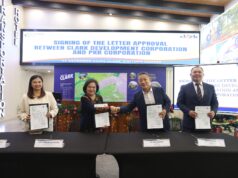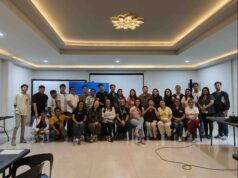(Dr. Lucille Abad, PNRI-DOST chemistry research section head and inventor of the carrageenan technology, explains the irradiation process at the launching of Vitalgro Carrageenan plant growth promoter at the Bliss Hotel in the City of San Fernando last Friday. Photo by Ashley Manabat)
CITY OF SAN FERNANDO – A breakthrough research in bio technology was launched at the Bliss Hotel here on Friday.
The Philippine Nuclear Research Institute (PNRI) presented the multi-awarded Vitalgro Carrageenan plant growth promoter (PGP) which it developed from seaweeds that contained phytohomone-like compounds that supports growth and development of crops.
Dr. Lucille Abad, PNRI-Department of Science and Technology (DOST) chemistry research section head, gave a brief explanation as inventor of the product which provides stem growth, efficient absorption of plant nutrients and increase in rice yield by 15 to 30 percent.
The scientist explained that carrageenan came from seaweeds (known locally as guso or gulamang dagat) and is organic since it is edible but was subjected to irradiation with gamma rays at their PNRI facility.
She said the PNRI gamma facility irradiate the seaweeds. “But it is a slow process so if we irradiate 2,000 liters it will last up to four days,” she said.
“So, now we achieve the same effect with the use of electron beam where 2,000 liters per hour can be produced… so we can now go commercial,” she explained.
Dr. Gil Magsino, agriculturist from the University of the Philippines Los Baňos (UPLB), conducted the pilot test in Pulilan, Bulacan and gave insights on how it was done during his talk.
Juliet Francisco, Pulilan, Bulacan agriculturist, gave a testimony on the eff ectivity of using the carrageenan technology.
She said Typhoon Lando struck just before harvest time during the field testing and wreaked havoc in the province. However, rice crops that were sprayed with carrageenan remained upright as compared to the fields surrounding the test area which were devastated.
Wilfredo F. Sibal, DOST chief science and research specialist, said the carrageenan project started since the time of former DOST Secretary Mario Montejo.
Sibal reiterated that carrageenan can increase rice yield and as well as pest and disease resistance as proven by field testing.
He said a combination of three technologies like a mechanical rice transplanter, hybrid seeds and carrageenan can increase rice yield of up to 200 cavans per hectare.
Sibal said it is now possible to attain this but everything started with carrageenan. “We are grateful to ma’am Lucy Abad of PNRI for coming up with this research idea and eventually graduating in the technology,” he said.
Claro Q. Torres, technical sales manager of Sunripe Agri Machineries, Inc., said his company is the distributor of the commercial product of the technology which is now known as Vitalgro Carrageenan PGP.





